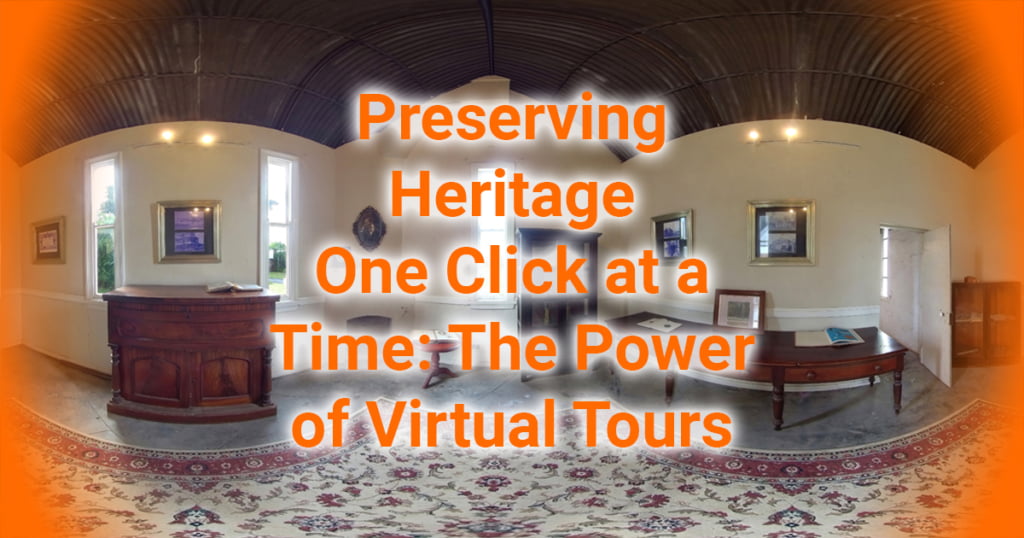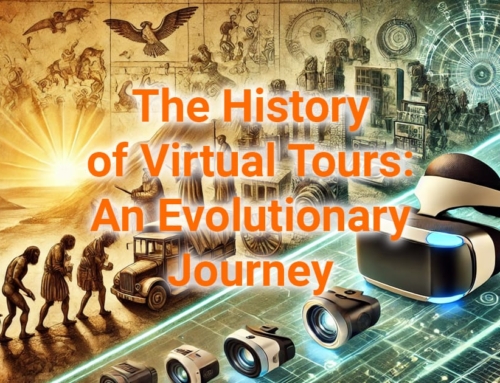Over the past few years, virtual tours have gained popularity, especially in heritage preservation. Modern technology has allowed individuals to create immersive and interactive virtual tours, allowing them to explore cultural landmarks and historical sites without leaving their homes. This blog delves into how virtual tours capture the past for heritage preservation, along with some instances of virtual tours that have successfully chronicled the past for future generations.
Preserving Heritage, One Click at a Time: The Power of Virtual Tours

Education
Virtual tours offer an innovative approach to preserving history and educating people about the past. With just one click, individuals can experience interactive tours of museums, historical sites and landmarks from the comfort of their own homes. This makes it easier to access and learn about heritage sites that may not be easily accessible due to distance or physical limitations. In addition, by using virtual tours for educational purposes, we can ensure that our history is not forgotten and is accessible to all.
Enhancing learning opportunities
Virtual tours are a powerful tool for bringing knowledge to life and providing interactive learning experiences. By creating immersive environments, virtual tours allow individuals to explore heritage sites and cultural landmarks in a way that fosters engagement and curiosity. This approach to learning enhances opportunities for students and educators alike, as it enables them to experience history in a way that is not always possible with traditional teaching methods. With the ability to explore historical sites as a 360 virtual tour and engage with interactive exhibits, virtual tours allow for a depth of exploration that is unparalleled.
Increasing engagement and retention rates
By utilising virtual tours, individuals can immerse themselves in a more engaging and captivating experience when learning about heritage sites and cultural landmarks. These tours offer a unique opportunity to explore and discover significant locations from the comfort of your own home, providing an educational and entertaining experience for all.
The immersive environments created through virtual tours foster engagement and curiosity, which leads to a deeper level of understanding and appreciation for history. Additionally, virtual tours encourage active participation, as individuals can explore and interact with exhibits and artifacts in a way that is not possible with traditional museum visits. This approach to learning increases retention rates, as individuals are more likely to remember information and details about the sites they have visited.
Supporting educational institutions
In addition to preserving heritage sites and cultural landmarks, virtual tours provide numerous advantages for educational institutions. Universities and colleges can use virtual tours to provide an immersive experience for prospective students, showcasing their campus and facilities.
These virtual campus tours can be accessed from anywhere worldwide, making it easier for international students to explore their options. Additionally, virtual tours can offer remote learning options, allowing students to attend classes and lectures from the comfort of their own homes. This is particularly useful for students with physical limitations or who live in rural areas. Finally, educational institutions can promote their online courses and programs through virtual tours, giving potential students a taste of what they can expect from their virtual classrooms.
Double-click on the virtual tour for Tebbutt’s Observatory to make it go fullscreen, or click here
Conservation
Preserving heritage is crucial for our understanding of history and culture. Virtual tours allow us to conserve historical sites, monuments and artifacts for future generations. Using technology to create a 360-degree experience, we can now explore and appreciate heritage sites from the comfort of our homes. Virtual tours have become an essential tool for conservation, not only for historical sites that may be inaccessible but also for those that require careful preservation.
Preserving historical and cultural sites
Documenting and preserving endangered locations is a crucial aspect of conservation. Virtual tours offer a way to document and preserve endangered locations that may not be accessible due to safety concerns or environmental damage. By creating a virtual tour of these locations, we can capture and preserve their unique qualities for future generations. Additionally, virtual tours provide a virtual archive of cultural heritage, allowing individuals to explore and appreciate heritage sites and artifacts that may not be physically accessible. This is particularly important for sites at risk of destruction due to natural disasters or human activity.
Finally, virtual tours can minimise the impact of tourism on natural sites by providing an alternative way for individuals to explore and appreciate these locations without physically visiting them. By reducing the number of visitors to these natural sites, we can help preserve them for future generations.
Promoting sustainable tourism
Virtual tours can also play a significant role in promoting sustainable tourism. By encouraging more responsible travel, individuals can explore heritage sites and cultural landmarks in a way that minimises their impact on the environment. Virtual tours also reduce the carbon footprint associated with traditional tourism, as individuals can explore sites from the comfort of their own homes. Additionally, virtual tours can support local economies and communities, as they provide a way for individuals to experience a location’s cultural and historical significance without physically travelling there. This can help promote sustainable tourism practices and support preserving heritage sites and cultural landmarks for future generations.
Advocating for eco-friendly initiatives
Promoting green energy and sustainable practices, raising awareness about environmental issues, and encouraging consumers to make sustainable choices are all important aspects of advocating for eco-friendly initiatives. By promoting the use of renewable energy sources and sustainable practices, we can reduce our environmental impact and promote a more sustainable future. Raising awareness about environmental issues through virtual tours can also help educate individuals about the importance of conservation and preservation. Finally, encouraging consumers to make sustainable choices can significantly reduce our carbon footprint and promote a more sustainable way of life. Through virtual tours, we can advocate for eco-friendly initiatives and promote a more sustainable future.
Protecting natural wonders and wildlife
Virtual tours can play an essential role in protecting natural wonders and wildlife. By creating a virtual experience for eco-tourism, individuals can learn and appreciate the beauty of these natural sites without causing harm to the environment. Documenting and preserving endangered species and habitats is another vital aspect of preserving our natural heritage. Virtual tours provide a way to showcase these species and habitats, allowing individuals to learn about them and appreciate their importance. Additionally, virtual tours can support conservation efforts through education and awareness. By promoting a deeper understanding of these natural sites and the need to protect them, virtual tours can encourage individuals to take action and support conservation initiatives.
Preserving intangible cultural heritage
Preserving intangible cultural heritage is another important aspect of virtual tours. By documenting traditional practices and customs, we can ensure that they are maintained and recorded over time. Virtual tours can provide a platform to showcase these traditions and customs, allowing individuals to learn about and appreciate them from anywhere in the world.
Virtual tours can promote cultural diversity by providing an opportunity to experience different customs and traditions. This can help break down cultural barriers and promote understanding and acceptance. Finally, virtual tours can help preserve the history of oral traditions and storytelling. By capturing and sharing these stories with a global audience, we can ensure that they are not lost and that future generations can appreciate and learn from them.
History
Preserving history has never been more critical. With virtual tours, we can now explore historical sites from the comfort of our own homes. Virtual tours allow us to immerse ourselves in a once-inaccessible world, giving us a glimpse into the past. The power of virtual tours lies in their ability to bring history to life and to ensure that future generations can experience the same sense of wonder and amazement that we do.
Enhancing historical experiences
Virtual tours provide a realistic portrayal of past events, allowing individuals to step back in time and experience history in a new and immersive way. By using technology to recreate historical settings, virtual tours offer a level of detail and accuracy that was once impossible. This provides a unique opportunity to explore historical sites and artifacts in an informative and engaging way. Additionally, virtual tours offer a virtual time-travel experience, allowing individuals to explore different eras and cultures from their homes. This can be particularly important for individuals who may have yet to have the opportunity to travel to these locations physically.
Finally, virtual tours can bring history to life for future generations. By preserving historical sites and artifacts in a virtual format, we can ensure that future generations have access to the same sense of wonder and amazement. This can promote a deeper understanding and appreciation of history and ensure that it is preserved for years.
Preserving historical landmarks and artifacts
Creating virtual archives of historic buildings and landmarks can help preserve these sites for future generations. By capturing highly-detailed 360 panoramic images of these structures, we can ensure that they are accurately represented and can be accessed by individuals worldwide. This can be particularly important for buildings at risk of destruction due to natural disasters or human activity. Protecting rare and fragile artifacts is another crucial aspect of preserving history.
Virtual tours can provide a safe way to showcase these artifacts, allowing individuals to view them in detail without risking damage or deterioration. Additionally, virtual tours can help document and share critical historical events, such as exhibitions or performances, ensuring that they are accessible to individuals unable to attend in person. By preserving historical landmarks and artifacts through virtual means, we can ensure that they are protected and accessible to individuals worldwide, promoting a deeper understanding and appreciation of our shared history.
Supporting historical tourism
Promoting cultural and heritage tourism is vital for preserving history. Virtual tours provide an innovative way for consumers to explore and learn about cultural and heritage sites from the comfort of their own homes. By offering this experience, we can encourage consumers to appreciate and value the importance of our history. In addition, virtual tours allow for a unique and interactive experience, enticing consumers to explore further and visit in person.
Innovation
Preserving heritage is crucial in ensuring that future generations can learn from the past. The power of virtual tours has revolutionised how we can explore and appreciate historical sites. With just a click, we can step back in time and experience the beauty and significance of heritage sites from our homes. The accessibility and convenience of virtual tours are invaluable in promoting awareness and appreciation of our rich history.
Advancing technology in tourism
In heritage and preservation, virtual tours have created marketing initiatives that showcase the importance of preserving our natural and cultural heritage. By creating immersive experiences through advanced technology, virtual tours offer a unique opportunity for individuals to explore and appreciate historical sites and landmarks worldwide. These virtual tours provide a deeper understanding of our shared history and cultural diversity and promote awareness and support for conservation efforts. Furthermore, by documenting intangible heritage and traditional practices, virtual tours can provide a platform for preserving and promoting cultural heritage. As technology advances, the possibilities for creating innovative and impactful marketing initiatives through virtual tours are limitless.
Encouraging creativity in marketing initiatives
The tourism industry is revolutionising by virtual tours emphasising heritage and preservation. These tours provide unique marketing opportunities that are innovative and engaging. These tours offer a unique and immersive way to showcase historical destinations, allowing marketers to create personalised and engaging content that resonates with potential visitors. By harnessing the power of virtual tours, tourism marketers can expand their reach beyond traditional methods and appeal to specific audiences.
With advanced technology, such as 360-degree cameras and high-quality graphics, these tours offer a realistic and interactive experience that encourages visitors to explore further. This innovative content can be shared across multiple channels, driving interest in heritage destinations and capturing the attention of potential visitors. The endless possibilities of immersive experiences and virtual travel inspire creativity in marketing initiatives, pushing the boundaries of what is possible in the tourism industry.
Inspiring future generations of travellers
Virtual tours that focus on heritage and preservation have the potential to inspire and shape the future of travel. These tours offer a unique and immersive way to showcase destinations, allowing marketers to create innovative content directly appealing to potential visitors. By utilising the power of virtual tours, marketers can personalise their messaging and offerings to specific audiences, expanding the scope of tourism marketing beyond traditional methods.
With advanced technology like 360-degree cameras and high-quality graphics, virtual tours offer a realistic and interactive experience that encourages visitors to explore further. This innovative content can inspire young people to travel and explore the world, which broadens their perspectives and fosters an appreciation for diversity. Furthermore, virtual tours can highlight the beauty and significance of different destinations, inspiring individuals to prioritise travel and seek out new experiences. Overall, marketing initiatives created from virtual tours with a heritage and preservation focus can inspire future generations to travel and explore while preserving our cultural and natural heritage.
Virtual tours help to preserve the past
Several steps can be taken to preserve our heritage and inspire future generations to explore the world. These include breaking down physical barriers and offering convenient experiences to cater to global audiences. It’s also important to support educational institutions and enhance learning opportunities. Furthermore, promoting sustainable tourism and preserving historical landmarks and artifacts are crucial. Lastly, encouraging creativity in marketing initiatives can help preserve our heritage one click at a time. Whether digitally or otherwise, these efforts will ensure that our heritage remains intact for future generations to explore and appreciate.
Are you a business or organisation looking to create a high-end 360 virtual tour to help drive sales? Contact us at 02 9674 9090, schedule a consultation, or fill out the form on this page to start a conversation for your virtual tour. Happy to discuss how we can create a high-end virtual experience for your organisation and design it to your needs.
Did we leave anything out about preserving our history and heritage through 360 virtual tours? Do you have a favourite historical virtual tour? Leave a comment down below and let us know :)








I think you have mentioned some very interesting details , thanks for the post.